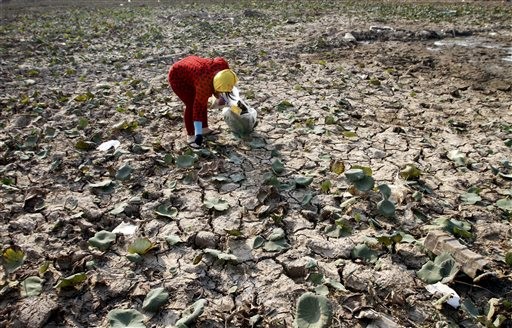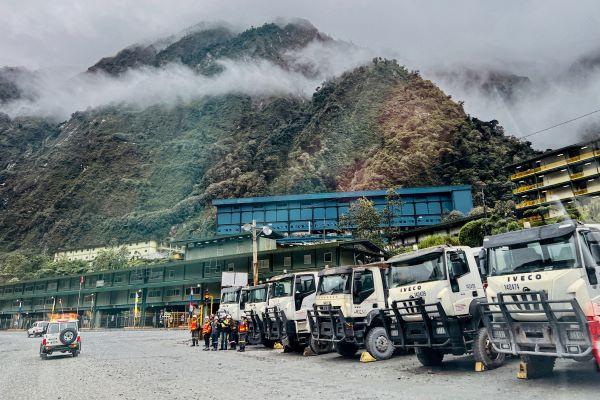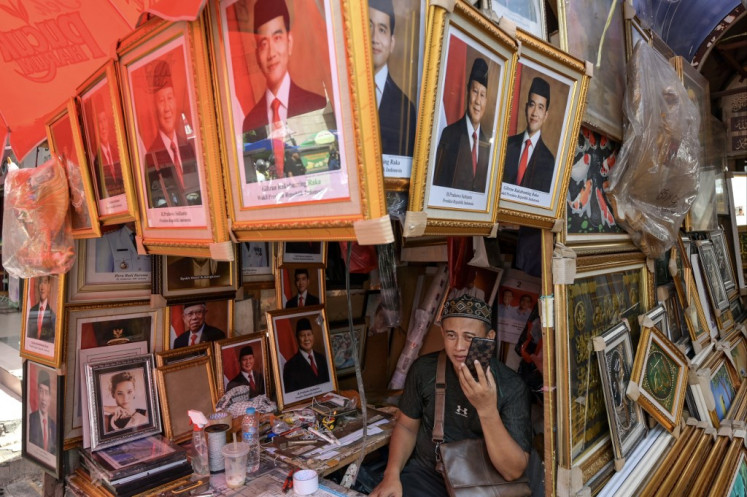Why ASEAN must pay more attention to the Mekong Delta
At an estimated 4,350 kilometers in length, it should be remembered that the Mekong River provides livelihoods to an estimated 60 million people who live along its basin, with 90 percent of Vietnam’s rice export coming from the Mekong Delta and Cambodia’s fresh water lake of Tonle Sap providing 60 percent of Cambodians’ protein intake.
Change Size
 A woman collects dried lotus leaves for her traditional medicine at Chreh village outside Phnom Penh, Cambodia, March 24. Tens of millions of people in the region are affected by the low level of the Mekong, a rice bowl-sustaining river system that flows into Laos, Thailand, Cambodia and Vietnam. (AP/Heng Sinith)
A woman collects dried lotus leaves for her traditional medicine at Chreh village outside Phnom Penh, Cambodia, March 24. Tens of millions of people in the region are affected by the low level of the Mekong, a rice bowl-sustaining river system that flows into Laos, Thailand, Cambodia and Vietnam. (AP/Heng Sinith)
T
he recent diplomatic spat between Indonesia and Singapore over the city-state’s effort to prosecute an Indonesian businessman for his alleged involvement in the haze last year was a frank reminder of the devastating impact man-made disasters can have on the region.
Yet while the regional haze — considered the worst since 1997 — attracted most of the headlines around the world, another man-made disaster has struck the ASEAN region virtually almost under the radar: the Mekong Delta drought.
The great Mekong River — which from its source in the Tibetan plateau of China passes through Myanmar, Laos, Thailand, Cambodia and Vietnam before flowing out to the South China Sea — is at its lowest level in a century after experiencing its worst dry spell in 90 years.
Experts suggest a combination of the stronger than-normal El Niño weather pattern, climate change and, most worryingly, the construction of dams along Mekong River, are responsible for this disaster.
At an estimated 4,350 kilometers in length, it should be remembered that the Mekong River provides livelihoods to an estimated 60 million people who live along its basin, with 90 percent of Vietnam’s rice export coming from the Mekong Delta and Cambodia’s fresh water lake of Tonle Sap providing 60 percent of Cambodians’ protein intake.
Indeed, the fishery sector of the Lower Mekong Basin is estimated at a total value of US$17 billion per year.
At the same time, the implications of the Mekong Delta drought go beyond the Mekong subregion.
As Richard Cronin from the Stimson Center in the United States notes, “People in Indonesia and the Philippines will go hungry if the Thais and Vietnamese don’t produce enough rice […] this is a preview of the longer-term effect of development and climate change to the Mekong Delta.”
A total of 11 mainstream hydropower dams and a further 30 tributary dams have been proposed for construction over the next 20 years.
These include the controversial Xayaburi Dam in Laos which has drawn opposition from neighboring Cambodia and Vietnam. The arguments in favor of such dam projects are that they provide cheaper electricity, will fuel economic development and alleviate poverty.
For a land-locked, impoverished country such as Laos with limited natural resources and a gross domestic product (GDP) of only $12 billion, the economic argument in favor of dam construction is obvious. Aiming for 7 percent GDP growth, the Lao government hopes to export the energy produced by its hydropower dams to neighboring countries.
Despite this, question marks have been raised over the supposed economic benefits and the purported minimal environmental impacts claimed by governments and dam companies.
Critics argue that existing and future dams threaten to reduce fish stocks, decrease the sediments needed for rice harvest, change the quality and quantity of water flows, and lead to unpredictable surges that will have major consequences on communities in the Mekong subregion.
These concerns appear to have materialized with one expert arguing fish yields have dropped by up to 70 percent due to hydropower dams and that whereas villagers reported they could catch 5 to 10 kilograms of fish a day 10 years ago, the catch has gone down to 1 to 2kg a day at present.
At the same time, changes to water flows caused by dams have affected rice yields. Areas that used to be dry in the dry season are now permanently inundated and areas that used to be flooded in the wet season remain dry.
For Vietnam’s Mekong Delta, which relies on the annual floods during the wet season to provide nutrient-rich sediments for its rice fields, such unseasonal droughts are devastating. One Vietnamese official suggested that mainstream hydropower projects on the Mekong River had caused a loss of $231 million in seafood and agriculture output to the Mekong Delta.
Given the transboundary nature of the issues surrounding water resource security in the Mekong subregion, it is unsurprising that efforts have been made at the regional level to ensure greater cooperation. The most notable regional mechanism is the Mekong Agreement of 1995 which established the Mekong River Commission (MRC).
MRC, however, is ineffective to manage the transboundary water resources due to the lack of legally binding agreements. Criticisms have also been made of the Mekong Agreement 1995 itself for its vague definitions of key terms such as the acceptable minimum monthly natural flow and natural reverse flow, and for the limited “notification” procedure that is required by riparian states to inform others about their water development projects.
As one expert pointed out, the agreement means upstream dams in Laos do not require the prior informed consent of Cambodia even though it may have a negative impact downstream.
As far back as 1997 ASEAN had already recognized the need to develop a regional water conservation program as stated in the Hanoi Plan of Action. Similarly in 2003, ASEAN senior officials on the environment adopted the ASEAN Long Term Strategic Plan for Water Resources Management, which identified five key challenges including moving towards integrated river basin management.
Two years later in 2005, ASEAN produced the ASEAN Strategic Plan of Action on Water Resources Management. Recognizing the importance of greater cooperation among riparian states in the Mekong subregion, in 2010 the ASEAN Secretariat announced at a signing ceremony in Hua Hin, Thailand, a partnership agreement with the MRC “in the development and management of the Mekong’s water resources”.
Despite all the efforts, it should be noted that the results of the institutional partnership between ASEAN and the MRC are “limited” due to lack of political will, leadership and resource mobilization.
Tellingly, at the 2010 signing ceremony, the then ASEAN Secretary-General did not attend but was instead represented by the Director of Finance and Infrastructure Directorate of the ASEAN Secretariat.
Moreover, the attendant community blueprints to the ASEAN Community Vision 2025 rarely mentions water resource security.
Indeed the term “water resources” is only found once under the ASEAN Socio-Cultural Community Blueprint 2025. Limiting water resources to the socio-cultural pillar is in stark contrast to the riparian states that identify it as a matter of national security.
One Cambodian think tank argues that “national state security is inextricably linked to water usage and management, and the stability of Cambodia as a state can in this manner be disrupted by factors contributing to water insecurity”. In this sense it is questionable why the issue was not included in the ASEAN Political-Security Community Blueprint 2025.
As such, while regional efforts to ensure water resource security in the Mekong Delta have been made, they have clearly not gone far enough. More attention needs to be given to water resource security in the Mekong subregion and it should be recognized by ASEAN as an issue of critical concern for the region, that has implications that go beyond the riparian states, and that it is a cross-pillar issue that cannot be limited to the socio-cultural realm. The lives of 60 million ASEAN citizens depend on it!
***
The writer heads the ASEAN Studies Program at The Habibie Center in Jakarta. The views expressed are his own.
---------------
We are looking for information, opinions, and in-depth analysis from experts or scholars in a variety of fields. We choose articles based on facts or opinions about general news, as well as quality analysis and commentary about Indonesia or international events. Send your piece to community@jakpost.com.









